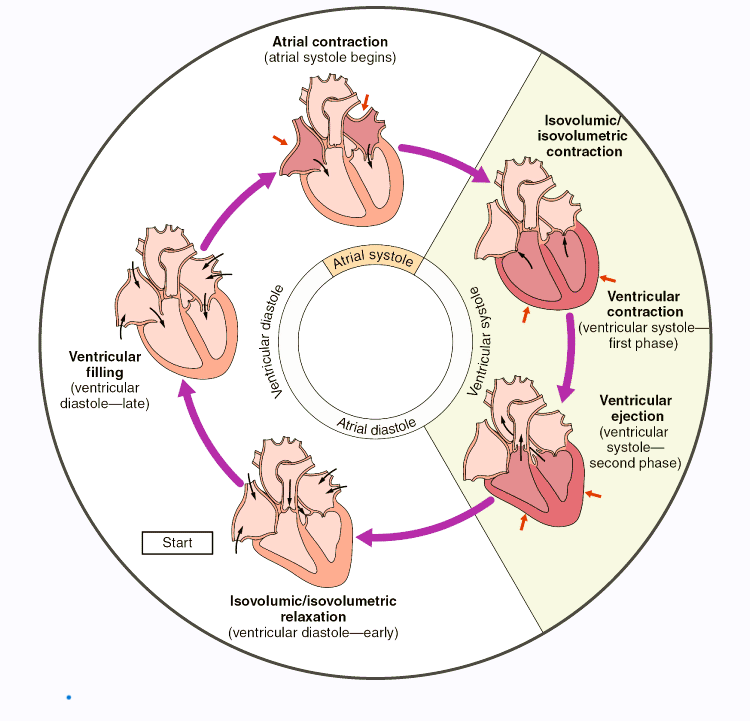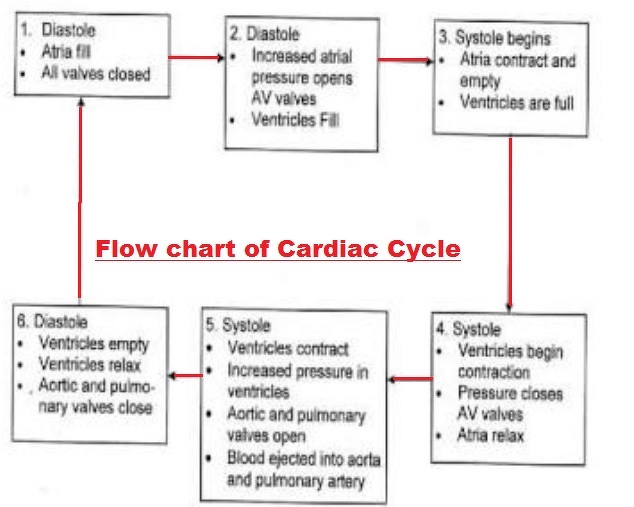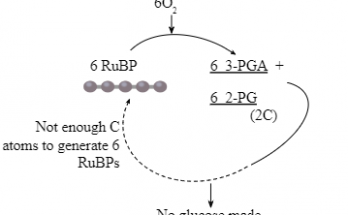What is a Cardiac Cycle ?
Cardiac cycle can be defined as the series of events that occur during one complete heartbeat. Cardiac Cycle includes the contraction and relaxation of the heart muscle and the flow of blood through the heart and blood vessels.
Cardiac cycle is responsible for pumping blood throughout the body, providing oxygen, nutrients to the tissues and organs, and removing waste products.
Cardiac cycle is the complex process of electrical and mechanical processes. It is regulated by the autonomic nervous system and various hormones. Understanding the cardiac cycle is essential for understanding normal heart function and for diagnosing and treating various cardiovascular diseases.
Also Check – 13 Important Functions of Heart
Phases of the Cardiac Cycle

The cardiac cycle is the sequence of events that occur during a single heartbeat, including the contraction and relaxation of the heart muscle and the filling and ejection of blood from the heart chambers.
The cardiac cycle is divided into two main phases –
- Diastole
- Systole.
Diastole
Diastole is the phase of the cardiac cycle during which the heart relaxes and fills with blood.
The diastolic phase is divided into following four stages-
- Isovolumic relaxation
- Rapid ventricular filling
- Diastasis
- Atrial contraction.
Isovolumic Relaxation
- In Isovolumic Relaxation Phase the heart is in a state of “Rest”.
- Isovolumic relaxation is an important phase of the cardiac cycle.It allows the ventricles to rest and prepare for the next phase of pumping blood.
- Isovolumic relaxation is a phase of the cardiac cycle that occurs immediately after the aortic and pulmonary valves close and before the mitral and tricuspid valves open. During Isovolumic relaxation the ventricles are not contracting, but they are not yet filling with blood either. This is because the mitral and tricuspid valves are closed, so blood cannot flow into the ventricles from the atria.
- Despite the lack of ventricular contraction there is still pressure in the ventricles due to the blood that was just ejected into the aorta and pulmonary artery during systole.
- This pressure causes the ventricular walls to remain tense and firm, but they are not shortening or actively contracting.
- Once the pressure in the ventricles drops below the pressure in the Atria, the Mitral and Tricuspid valves will open and the ventricles will begin to fill with blood, starting the next phase of the cardiac cycle.
Rapid Ventricular Filling
- Rapid ventricular filling is essential for maintaining a healthy and efficient cardiac cycle.. It allows the ventricles to fill with blood properly and prepares the heart for the next phase of the cycle.
- Rapid ventricular filling is a phase of the cardiac cycle that occurs immediately after the mitral and tricuspid valves open and blood begins to flow from the atria into the ventricles.
- During the Rapid ventricular filling phase the pressure in the atria is higher than the pressure in the ventricles. It allows blood to flow freely into the ventricles.
- As the ventricles fill with blood, they begin to stretch and expand, causing the ventricular walls to become thinner. This is known as ventricular compliance. The expansion of the ventricles also causes a decrease in ventricular pressure, which further promotes the filling of the ventricles.
- Rapid ventricular filling is an important part of the cardiac cycle, as it ensures that the ventricles are adequately filled with blood before the next phase of the cycle i.e the diastasis phase. In the diastasis phase the ventricles continue to fill with blood but at a slower rate, until the next phase of the cycle, which is the atrial contraction.
Diastasis
- Diastasis is a phase of the cardiac cycle that occurs between the Rapid Ventricular Filling phase and the Atrial Contraction Phase.
- Diastasis is a crucial part of the cardiac cycle. It helps to maintain the volume and pressure in the ventricles and prepares the heart for the next phase of pumping blood.
- During the Diastasis phase the ventricles continue to fill with blood but at a slower rate. This is because the pressure in the atria and ventricles is roughly equal, so there is no longer a significant pressure gradient driving blood flow.
- In diastasis the ventricles are in a state of relative relaxation but they are still receiving blood from the Atria. The ventricular walls are still stretched and expanded from the rapid ventricular filling phase and the ventricular pressure remains low.
- Diastasis is an important part of the cardiac cycle, as it allows the ventricles to continue filling with blood at a slower rate. This helps to maintain the ventricular volume and prepare the heart for the next phase of the cycle i.e Atrial Contraction.
Atrial Contraction
- Atrial contraction is a phase of the cardiac cycle during which the atria of the heart contract to push blood into the ventricles. It occurs during the end of the diastole phase i.e just before the ventricles contract during systole.
- Atrial contraction is a brief but important phase of the cardiac cycle during which the atria of the heart contract to push blood into the ventricles . It helps to ensure that the ventricles are adequately filled with blood before they contract during ventricular systole.
- During atrial contraction the atria contract. It causes a small increase in pressure that helps to force the remaining blood in the atria into the ventricles. The contraction of the atria is driven by electrical impulses that originate from the sinoatrial (SA) node. Sinoatrial (SA) node is the natural pacemaker of the heart.
Also Check – Describe the Flow of Blood through the Heart of Human Beings
Systole
Systole is the phase of the cardiac cycle during which the heart contracts to pump blood out of the chambers and into the blood vessels.
The systolic phase is divided into two stages:
- Atrial Systole
- Ventricular Systole.
Atrial Systole
- Atrial Systole is a phase of the cardiac cycle that occurs after the diastasis phase.
- Atrial Systole or contraction is a crucial part of the cardiac cycle. It ensures that the ventricles are optimally filled with blood before they contract. It also helps to maintain appropriate blood flow throughout the body.
- During Atrial Systole or contraction phase the atria contract to push the remaining blood into the ventricles. The atrial contraction phase is also known as the “Atrial Kick” because it provides an extra forceful push of blood into the ventricles.
- Atrial contraction begins when the atria receive electrical signals from the sinoatrial (SA) node. The electrical signals cause the atria to contract and push the remaining blood into the ventricles. The Atrioventricular (AV) node is the electrical gateway between the atria and ventricles, delaying the electrical signal for a brief moment allowing the ventricles to fill completely before they contract.
- Atrial contraction is important for maintaining the appropriate amount of blood flow through the heart and into the body. It also helps to optimize cardiac output by ensuring that the ventricles are filled to their maximum capacity before they contract.
Ventricular Systole
Ventricular systole is a phase of the cardiac cycle during which the ventricles of the heart contract to pump blood out to the lungs and the rest of the body. It is an essential part of the heart’s pumping action. Ventricular systole follows the Atrial systole, during which the ventricles contract to pump blood out of the heart.
Ventricular systole is divided into two phases
- Isovolumic contraction
- Ejection
Isovolumic Contraction
In Isovolumic Contraction Phase the ventricles begin to contract but the pressure inside them is not yet high enough to open the semilunar valves leading to the pulmonary artery and aorta.The atrioventricular valves also close during this phase. This means that the blood inside the ventricles is not yet being ejected, and so the volume of blood inside the ventricles remains constant i.e.Isovolumic .
Ejection
As the ventricles continue to contract, the pressure inside them increases.It eventually reaches a point where it exceeds the pressure in the pulmonary artery and aorta. This pressure causes the semilunar valves to open and blood is ejected from the ventricles into these vessels.

Also Check – Why is it necessary to separate Oxygenated and Deoxygenated Blood
Heart Sounds – Sounds that the Heart produces during the Cardiac Cycle
During the cardiac cycle the heart produces two distinct sounds
- The first heart sound (S1)
- The second heart sound (S2)
These sounds are created by the closing of the heart valves as the blood flows through the heart.
First Heart Sound (S1)
The first heart sound (S1) is created by the closing of the atrioventricular valves (tricuspid and mitral) during ventricular systole. S1 is often described as a “lub” sound and marks the beginning of systole.
Second Heart Sound (S2)
The second heart sound (S2) is created by the closing of the semilunar valves (pulmonary and aortic) during ventricular diastole. S2 is often described as a “dub” sound and marks the end of systole.
Additional Heart Sounds
In addition to S1 and S2 some individuals may have additional heart sounds such as S3 and S4. S3 is created by the rapid filling of the ventricles during early diastole, while S4 is created by the atria contracting to push blood into the ventricles during late diastole.
Diagnosing Heart Conditions by Heart sounds
Heart sounds that occur during the cardiac cycle are important for diagnosing heart conditions and understanding the function of the heart valves.
The sounds of the heart can be used to diagnose certain heart conditions. For example a heart murmur is an abnormal sound that occurs when blood flows through a narrow or leaking heart valve. A doctor may use a stethoscope to listen to a patient’s heart sounds and identify the presence of a heart murmur.
Regulation of the Cardiac Cycle
The regulatory mechanisms that affect the cardiac cycle are important for understanding how the heart responds to different physiological and environmental conditions.
The cardiac cycle is regulated by both the nervous system and hormones in the body. These regulatory mechanisms help ensure that the heart beats at an appropriate rate and rhythm to meet the body’s needs.
Nervous System Regulation
The nervous system plays a key role in regulating the cardiac cycle. The sympathetic nervous system, which is responsible for the body’s “fight or flight” response, increases heart rate and contractility by releasing the hormone epinephrine (also known as adrenaline). The parasympathetic nervous system, which is responsible for the body’s “rest and digest” response, slows heart rate by releasing the hormone acetylcholine.
Hormonal Regulation
Hormones such as epinephrine, norepinephrine, and thyroid hormones can also affect the cardiac cycle. Epinephrine and norepinephrine are released by the adrenal gland in response to stress and can increase heart rate and contractility. Thyroid hormones can also increase heart rate and contractility by increasing the number of beta-adrenergic receptors in the heart.
Factors Affecting Heart Rate and Rhythm
Factors such as exercise, stress, and certain medications can affect heart rate and rhythm. During exercise the body’s oxygen and energy demands increase which leads to an increase in heart rate to meet these demands. Stress can also increase heart rate and contractility through the release of epinephrine and norepinephrine. Certain medications such as beta-blockers can slow heart rate and reduce contractility by blocking the effects of epinephrine and norepinephrine on the heart.
Frequently asked questions on this topic
What is the cardiac cycle?
The cardiac cycle is the series of events that occur during one complete heartbeat, including the contraction and relaxation of the heart muscle.
What are the main functions of the cardiac cycle?
The main functions of the cardiac cycle are to maintain blood flow through the body and to ensure that oxygen and nutrients are delivered to the tissues and organs. It also helps to remove waste products from the body.
What are the phases of the cardiac cycle?
The phases of the cardiac cycle are: atrial systole, isovolumic contraction, rapid ventricular ejection, reduced ventricular ejection, isovolumic relaxation, rapid ventricular filling, diastasis and atrial contraction
What happens during the diastolic phase?
During the diastolic phase, the heart muscle relaxes and the chambers fill with blood.
What are the four stages of the diastolic phase?
The four stages of the diastolic phase are: isovolumic relaxation, rapid ventricular filling, diastasis and atrial contraction.
What is isovolumic relaxation?
Isovolumic relaxation is the brief period of time during which the ventricles are completely closed off and the heart is not actively pumping blood.
What happens during the rapid ventricular filling phase?
During the rapid ventricular filling phase, blood flows from the atria into the ventricles at a rapid pace.
Why is rapid ventricular filling important for the cardiac cycle?
Rapid ventricular filling is important for the cardiac cycle because it helps to ensure that the ventricles are properly filled with blood before they begin to contract.
What happens during the diastasis phase?
During the diastasis phase, the heart muscle is in a state of relaxation and the flow of blood into the ventricles slows down.
Why is diastasis important for the cardiac cycle?
Diastasis is important for the cardiac cycle because it allows the heart to rest and recover before the next contraction.
What happens during the atrial contraction phase?
During the atrial contraction phase, the atria contract and push blood into the ventricles.
What is the role of the atrial contraction phase in the cardiac cycle?
The role of the atrial contraction phase is to ensure that the ventricles are fully filled with blood before they begin to contract, which helps to maintain proper blood flow and ensure that oxygen and nutrients are delivered to the body’s tissues and organs.
What are the two distinct sounds produced by the heart during the cardiac cycle?
The two distinct sounds produced by the heart during the cardiac cycle are the first heart sound (S1) and the second heart sound (S2).
What causes the first heart sound (S1) and what does it signify?
The first heart sound (S1) is caused by the closing of the atrioventricular valves (tricuspid and mitral) during ventricular systole. It signifies the beginning of systole.
What causes the second heart sound (S2) and what does it signify?
The second heart sound (S2) is caused by the closing of the semilunar valves (pulmonary and aortic) during ventricular diastole. It signifies the end of systole.
What are the additional heart sounds that some individuals may have and how are they created?
Some individuals may have additional heart sounds such as S3 and S4. S3 is created by the rapid filling of the ventricles during early diastole, while S4 is created by the atria contracting to push blood into the ventricles during late diastole.
How are heart sounds important for diagnosing heart conditions?
Heart sounds that occur during the cardiac cycle are important for diagnosing heart conditions and understanding the function of the heart valves. Abnormal heart sounds such as heart murmurs can indicate issues with the heart valves.
What is a heart murmur and how can it be detected using heart sounds?
A heart murmur is an abnormal sound that occurs when blood flows through a narrow or leaking heart valve. It can be detected using a stethoscope to listen to a patient’s heart sounds.
What are the regulatory mechanisms that affect the cardiac cycle?
The regulatory mechanisms that affect the cardiac cycle include the nervous system and hormones in the body.
How does the sympathetic nervous system regulate the cardiac cycle?
The sympathetic nervous system increases heart rate and contractility by releasing the hormone epinephrine (also known as adrenaline).
How does the parasympathetic nervous system regulate the cardiac cycle?
The parasympathetic nervous system slows heart rate by releasing the hormone acetylcholine.
What hormones can affect the cardiac cycle and how do they do so?
Hormones such as epinephrine, norepinephrine and thyroid hormones can affect the cardiac cycle. Epinephrine and norepinephrine can increase heart rate and contractility, while thyroid hormones can increase heart rate and contractility by increasing the number of beta-adrenergic receptors in the heart.
How can factors such as exercise, stress and medication affect heart rate and rhythm?
Factors such as exercise, stress and medication can affect heart rate and rhythm. Exercise increases heart rate to meet increased oxygen and energy demands, while stress can increase heart rate and contractility through the release of epinephrine and norepinephrine. Medications such as beta-blockers can slow heart rate and reduce contractility by blocking the effects of epinephrine and norepinephrine on the heart.

2 Comments on “Cardiac Cycle – Class 11th ”